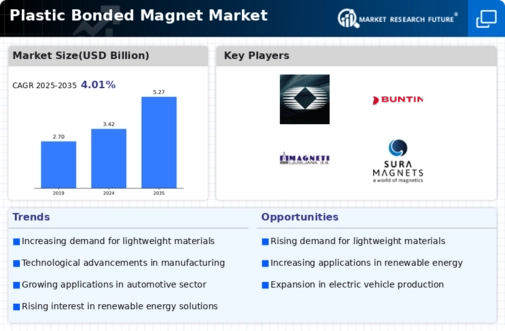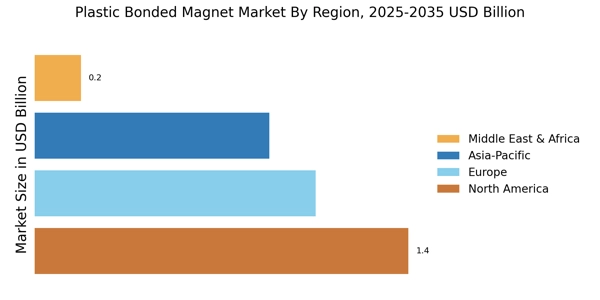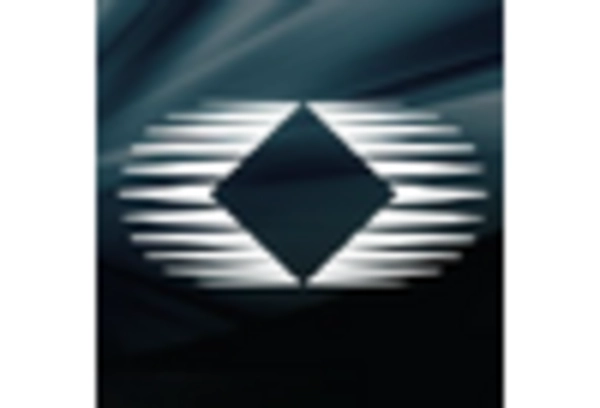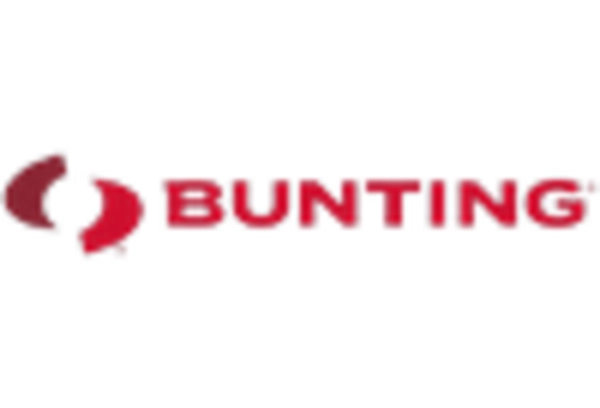The Plastic Bonded Magnet Market is currently characterized by a dynamic competitive landscape, driven by technological advancements and increasing demand across various sectors, including automotive, electronics, and renewable energy. Key players such as Hitachi Metals (Japan), Magnet Applications (US), and Bunting Magnetics (US) are strategically positioning themselves through innovation and regional expansion. Hitachi Metals (Japan) has focused on enhancing its product portfolio by investing in research and development, which appears to be a critical factor in maintaining its competitive edge. Meanwhile, Magnet Applications (US) emphasizes partnerships with local manufacturers to optimize supply chains, thereby improving operational efficiency and responsiveness to market demands. Collectively, these strategies contribute to a moderately fragmented market structure, where collaboration and innovation are pivotal for sustaining competitive advantage.
In terms of business tactics, companies are increasingly localizing manufacturing to reduce lead times and costs, while also optimizing their supply chains to enhance resilience. The market structure remains moderately fragmented, with several players vying for market share. This fragmentation allows for niche players to thrive, yet the influence of major companies is significant, as they set trends and standards that smaller firms often follow. The collective actions of these key players shape the competitive environment, fostering a climate of innovation and responsiveness to consumer needs.
In August 2025, Bunting Magnetics (US) announced the opening of a new manufacturing facility in the Midwest, aimed at increasing production capacity for plastic bonded magnets. This strategic move is likely to enhance their market presence and reduce shipping times for clients in North America, thereby improving customer satisfaction. The establishment of this facility underscores Bunting's commitment to meeting the growing demand for high-performance magnets in various applications, particularly in the automotive sector, where lightweight materials are increasingly sought after.
In September 2025, Arnold Magnetic Technologies (US) unveiled a new line of eco-friendly plastic bonded magnets, which are produced using sustainable materials. This initiative not only aligns with global sustainability trends but also positions Arnold as a leader in environmentally conscious manufacturing. The introduction of these products may attract a new customer base that prioritizes sustainability, thereby enhancing Arnold's competitive positioning in the market.
In October 2025, Ningbo Yunsheng (China) announced a strategic partnership with a leading electric vehicle manufacturer to supply custom plastic bonded magnets for their next-generation vehicles. This collaboration is indicative of the growing trend towards electrification in the automotive industry, and it positions Ningbo Yunsheng to capitalize on the increasing demand for high-performance magnets in electric vehicles. Such partnerships are likely to become more prevalent as companies seek to leverage each other's strengths to drive innovation and market penetration.
As of October 2025, the competitive landscape of the Plastic Bonded Magnet Market is increasingly defined by trends such as digitalization, sustainability, and the integration of artificial intelligence in manufacturing processes. Strategic alliances are becoming more common, as companies recognize the value of collaboration in enhancing innovation and market reach. Looking ahead, it appears that competitive differentiation will increasingly hinge on technological advancements and supply chain reliability, rather than solely on price. This shift suggests that companies that prioritize innovation and sustainability will likely emerge as leaders in the evolving market.


















Leave a Comment